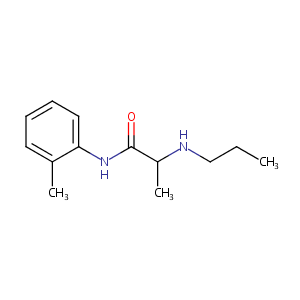Details of the Drug
General Information of Drug (ID: DMI7DZ2)
| Drug Name |
Prilocaine
|
||||||||||||||||||||||||||
|---|---|---|---|---|---|---|---|---|---|---|---|---|---|---|---|---|---|---|---|---|---|---|---|---|---|---|---|
| Synonyms |
Citanest; Prilocaina; Prilocainum; Propitocaine; Prilocaine [USAN]; Prilocaine base; Astra 1512; Astra 1515; L 67; Citanest (TN); Prilocaina [INN-Spanish]; Prilocainum [INN-Latin]; Propitocaine (JAN); Prilocaine (USP/INN); O-Methyl-2-propylaminopropionanilide; O-Methyl-alpha-propylaminopropionanilide; Alpha-n-Propylamino-2-methylpropionanilide; N-[2-Methylphenyl]-2-[propylamino]propanamide; N-(2-methylphenyl)-N2-propylalaninamide; N-(2-Methylphenyl)-2-(propylamino)propanamide; N-(2-methylphenyl)-N(2)-propylalaninamide; Propanamide, N-(2-methylphenyl)-2-(propylamino)-(9CI); 2-(Propylamino)-o-propionotoluidide; 2-Methyl-.alpha.-propylaminopropionanilide; 2-Methyl-alpha-propylaminopropionanilide
|
||||||||||||||||||||||||||
| Indication |
|
||||||||||||||||||||||||||
| Therapeutic Class |
Anesthetics
|
||||||||||||||||||||||||||
| Affected Organisms |
Humans and other mammals
|
||||||||||||||||||||||||||
| ATC Code | |||||||||||||||||||||||||||
| Drug Type |
Small molecular drug
|
||||||||||||||||||||||||||
| Structure |
 |
||||||||||||||||||||||||||
| 3D MOL | 2D MOL | ||||||||||||||||||||||||||
| #Ro5 Violations (Lipinski): 0 | Molecular Weight (mw) | 220.31 | |||||||||||||||||||||||||
| Logarithm of the Partition Coefficient (xlogp) | 2.1 | ||||||||||||||||||||||||||
| Rotatable Bond Count (rotbonds) | 5 | ||||||||||||||||||||||||||
| Hydrogen Bond Donor Count (hbonddonor) | 2 | ||||||||||||||||||||||||||
| Hydrogen Bond Acceptor Count (hbondacc) | 2 | ||||||||||||||||||||||||||
| ADMET Property |
|
||||||||||||||||||||||||||
| Chemical Identifiers |
|
||||||||||||||||||||||||||
| Cross-matching ID | |||||||||||||||||||||||||||
| Combinatorial Drugs (CBD) | Click to Jump to the Detailed CBD Information of This Drug | ||||||||||||||||||||||||||
| Repurposed Drugs (RPD) | Click to Jump to the Detailed RPD Information of This Drug | ||||||||||||||||||||||||||
Molecular Interaction Atlas of This Drug
 Drug Therapeutic Target (DTT) |
|
||||||||||||||||||||||||||||||||||||
|---|---|---|---|---|---|---|---|---|---|---|---|---|---|---|---|---|---|---|---|---|---|---|---|---|---|---|---|---|---|---|---|---|---|---|---|---|---|
 Drug Off-Target (DOT) |
|
||||||||||||||||||||||||||||||||||||
| Molecular Interaction Atlas (MIA) | |||||||||||||||||||||||||||||||||||||
Drug-Drug Interaction (DDI) Information of This Drug
|
Coadministration of a Drug Treating the Disease Different from Prilocaine (Comorbidity)
|
||||||||||||||||||||||||||||||||||||||||||||||||||||||||||||||||||||||||||||||||||||||||||||||||||||||||||||||||||||||||||||||||||
References
